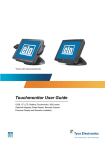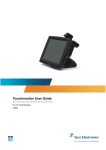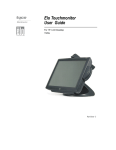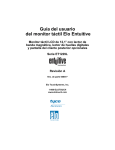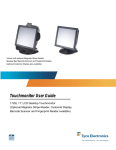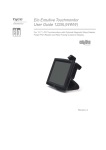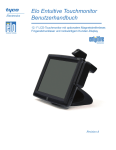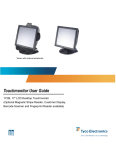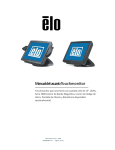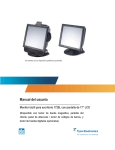Download Elo TouchSystems 1529L User guide
Transcript
* Shown with optional peripherals Touchmonitor User Guide 1529L 15” LCD Desktop Touchmonitor, 3000 series (Optional Magnetic Stripe Reader, Barcode Scanner, Customer Display and Biometric available) Elo Touchmonitor User Guide 15" LCD Desktop 1529L Revision F P/N 008603E Elo TouchSystems. 1-800-ELOTOUCH www.elotouch.com Copyright © 2008 Tyco Electronics. All Rights Reserved. No part of this publication may be reproduced, transmitted, transcribed, stored in a retrieval system, or translated into any language or computer language, in any form or by any means, including, but not limited to, electronic, magnetic, optical, chemical, manual, or otherwise without prior written permission of Elo TouchSystems. Disclaimer The information in this document is subject to change without notice. Elo TouchSystems makes no representations or warranties with respect to the contents hereof, and specifically disclaims any implied warranties of merchantability or fitness for a particular purpose. Elo TouchSystems reserves the right to revise this publication and to make changes from time to time in the content hereof without obligation of Elo TouchSystems to notify any person of such revisions or changes. Trademark Acknowledgments IntelliTouch, SecureTouch, AccuTouch, and MonitorMouse are trademarks of Elo TouchSystems. Other product names mentioned herein may be trademarks or registered trademarks of their respective companies. Elo TouchSystems claims no interest in trademarks other than its own. Table of Contents Chapter 1 Introduction 1 Product Description ................................................. 1 Detailed LCD Display Performance Requirements .......................................................... 2 Customer Display .............................................. 3 Serial Version ................................................. 3 Fingerprint Reader ............................................ 3 Theory of Operation ....................................... 4 Sensor Specifications ..................................... 4 Credit Card Reader ........................................... 4 Barcode Scanner .............................................. 4 Omni-directional scanner ................................ 4 Single scanner ................................................ 5 Six Port USB Hub ............................................. 5 External 12 VDC Power Supply ........................ 5 Chapter 2 Installation and Setup 7 Unpacking Your Touchmonitor. ............................... 7 Product Overview .................................................... 8 Main Unit ........................................................... 8 Rear View .......................................................... 8 Side View .......................................................... 9 Base Bottom View ............................................. 9 Kensington™ Lock ............................................ 10 USB Interference Connection ................................. 11 Remove the back cover .................................... 11 Replace the cable cover .................................... 16 USB/Serial Interference Connection ....................... 17 Remove the back cover .................................... 17 Replace the cable cover .................................... 23 Optimizing the LCD Display .................................... 24 Installing the Peripheral Device Drivers .................. 24 Finger Print Reader ........................................... 24 Magnetic Stripe Reader .................................... 25 Testing the USB MSR Keyboard Emulation ... 25 Testing the USB-HID Class MSR .................... 25 Convert MSR from HID to Keyboard emulation ........................................................ 25 Convert MSR from Keyboard emulation to HID ................................................................. 26 Rear Facing Customer Display ......................... 26 Barcode Scanner .............................................. 27 Installing the Touch Driver Software ....................... 29 Installing the USB Touch Driver ........................ 30 Installing the USB Touch Driver for Windows XP, Windows 2000, Me, 98 .............................. 30 Chapter 3 Operation About Touchmonitor Adjustments ....................... 15” LCD Function Key ......................................... Controls and Adjustment ............................... OSD Lock/Unlock ....................................... Power Lock/Unlock .................................... OSD Menu Functions ................................. OSD Control Options ................................. Brightness .................................................. Contrast ...................................................... Saturation, Hue, Flesh Tones ..................... Phase ......................................................... Auto Adjust ................................................. OSD Left/Right ........................................... OSD Up/Down ............................................ Clock .......................................................... Color Temperature ..................................... Current Input .............................................. OSD Position .............................................. Language ................................................... Recall Defaults ........................................... Input Timeout ............................................. Power-Save (No Input) .............................. Power LED Display & Power Saving ............. General Power Saving Mode ..................... Display Angle ...................................................... Controls and Adjustment ..................................... OSD Lock/Unlock .......................................... Power Lock/Unlock ....................................... OSD Menu Functions .................................... OSD Control Options .................................... Brightness .................................................. Contrast ...................................................... Saturation, Hue, Flesh Tones ..................... Phase ......................................................... Auto Adjust ................................................. OSD Left/Right ........................................... OSD Up/Down ............................................ Clock .......................................................... Color Temperature ..................................... Current Input .............................................. OSD Position .............................................. Language ................................................... Recall Defaults ........................................... OSD Timeout .............................................. Input Video Select ...................................... Volume ....................................................... 31 32 33 33 33 33 34 34 34 34 34 34 34 34 34 34 34 34 35 35 35 35 35 35 35 37 37 37 37 38 38 38 38 38 38 38 38 38 38 38 38 38 39 39 39 39 Chapter 4 Troubleshooting 41 Solutions to Common Problems ......................... 41 31 Appendix A Native Resolution 43 Appendix B Touchmonitor Safety 45 Care and Handling of Your Touchmonitor ........... 46 Appendix C Technical Specifications Touchmonitor Specifications ......................... AccuTouch Touchscreen Specifications ................................................ IntelliTouch Touchscreen Specifications ................................................ Infrared Touchscreen Specifications ................................................ Acoustic Pulse Recognition Specifications ................................................ 15” LCD Touchmonitor (1529L-XXXA-1-XX-G) Dimension ................ 15” LCD Touchmonitor (1529L-XXXA-1-XX-T-G) Dimension ............ 47 48 49 50 51 52 53 53 Regulatory Information 55 Warranty 59 Index 62 C H A P T E R 1 INTRODUCTION Product Description The 1529L is a retail terminal designed to present information to the operator and the customer. The 1529L is available in serial and USB versions or combo touch monitor. The 1529L consists of a 15.0” LCD main display with a touchscreen and the following optional peripherals: customer display, vacuum fluorescent display (VFD) Customer Display, fingerprint reader, barcode scanner, credit card reader, and a 6 port USB (USB version only) Hub. The main display element is a 15.0 inch diagonal XGA resolution (1024 x 768) LCD display. The main display will consist of an LCD Display and touchscreen. Four types of touchscreens can be selected in the 1529L as options. They are AccuTouch, Intellitouch, and carrollTouch and Acoustic Pulse Recognition. The fingerprint reader translates illuminated images of fingerprints into digital code for further software processing, e.g. enrollment (fingerprint registration) and verification (authentication of registered users). The fingerprint reader uses the SEIR method and CMOS image sensor to capture high contrast, high resolution fingerprint images. A series of algorithms extracts minutiae data from the image, mapping the distinguishing characteristics of fingerprint ridge ends, splits, dots, and arches. To identify or verify a fingerprint, a proprietary matching algorithm compares the extracted minutiae points from the input fingerprint on the optical module to a previously stored sample. The entire matching process takes roughly one second. There is a fingerprint reader available in the USB version of the 1529L. 1-1 The credit card reader reads all three stripes on a standard credit card or drivers license. The credit card is read by sliding the credit card, stripe side toward the display through the credit card reader forward or backward. There is a USB credit card reader only. The Hub provides 4 internal USB ports to be used by the credit card reader, the fingerprint reader or barcode scanner, the touchscreen, and the customer display. The hub also supplies two USB ports to the outside of the back of the 1529L for external use. The hub is only used by the USB version of the 1529L. The 1529L is powered by a universal AC power source or 12 VDC from external power source. The barcode scanner comes in two different configurations. The first is a high-end omni-directional scanner, which is also capable of reading 2-D barcodes. And the second is a lower cost, yet efficient, 1-D scanner. Both scanners run on a USB interface. Detailed LCD Display Performance Requirements 15 inch TFT LCD Display Panel Display Format Display area 15” 1024 x 768 304.1mm(H) x 228mm(V) Pixel Pitch 15” Contrast Ratio 0.297mm(H) x 0.297mm(V) 400:1 typical Brightness LCD 350 cd/m2 (Typical) AccuTouch IntelliTouch 280 cd/m2 (Typical) 322 cd/m2 (Typical) CarrollTouch Surface Capacitive 322 cd/m2 (Typical) 298 cd/m2 (Typical) Acoustic Pulse Recognition Accutouch Transmission 322 cd/m2 (Typical) 82% typical IntelliTouch Transmission IR Touchscreen Transmission 92% typical 92% typical Surface Capacitive Transmission Acoustic Pulse Recognition 84% typical 92% typical Response Time Display Color Tr=4 msec/Tf=12msec typical 16.2 million colors, 6 Bit with dithering Vertical Viewing Angle Typical Vertical Viewing Angle: 60deg(looking down)/40 deg(lookingup) @ CR>=10 Horizontal Viewing Angle Typical Vertical Viewing Angle: 60deg(looking down)/60 deg(lookingup) @ CR>=10 1-2 Elo Touchmonitor User Guide Customer Display The Customer Display is a twenty character two line vacuum fluorescent display (VFD). It consists of a VFD and VFD controller. Serial Version Optional Parameters Characters per row Number of rows Character configuration Character Height Character width Character configuration Character color MTBF 20 2 5x7 dot matrix 9.5mm 6.2mm ASCII Blue green 300,000 hours Fingerprint Reader There is a fingerprint reader in the USB version only. General Description-FDU01B is a PC peripheral FRD (Fingerprint Recognition Device) for USB (Universal Serial Bus) connections. 1-3 Specifications Sensor Image Capture Speed Image Transfer Speed Pixel Resolution USB Signaling Type SecuGen FOR 600ms/frame 500Byte/ms 356x292 Full Speed Type Theory of Operation The USB host initiates communication with the FDU01 using operation commands (Sensor LED On, Fingerprint Capture Start and Stop). Fingerprint data are then captured by the CMOS sensor at a total image size of 356 x 292 with 8-bit gray level. The image frame transfer speed is 500 bytes/ms. It takes about 600 milliseconds to send one frame of image data over USB protocols. FDU01 uses the SecuGen FOR (Fingerprint Optic Reader). Sensor Specifications Sensor Resolution Verifying Time Image Capture Error Rate Life Time Typically CMOS Image Sensor 500dpi <1sec <0.1% 40,000Hrs Credit Card Reader There is a USB credit card reader only. The USB version is available in HID and Keyboard emulation versions. The reader reads all three stripes on a standard credit card or drivers license. Reference Standards-Conform to applicable standards Message Format Card Speed MTBF Electronics International Standards Organization, American National Standards Institute, California Drivers License, American Association of Motor Vehicle Administrators ACCII 3 to 50 IPS 125,000 hrs; Head 1,000,000 passes Barcode Scanner Omni-directional scanner: 1. Ability to read 1D codes with a 360º rotation, eliminating the need to orient the scanner in the field of view 2. Scan angle Minimum horizontal: 34º ± 1.5º Minimum vertical: 12.5º ± 1.5º 3. Ability to read 2-D barcodes (PDF417, Micro PDF) 4. Ability to read damaged or poorly printed barcodes 1-4 Elo Touchmonitor User Guide 5. Effective form factor; ability to be mounted on side of ET1529L 6. USB interface that complies with USB 2.0 standards 7. USB bus powered 8. Easy communication between host and scanner 9. Visible laser diode operating at 650nm 10.600+ scans/sec 1-D scanner: 1. Ability to read 1-D codes 2. Scan angle Minimum: 47º ± 3º 3. Low cost solution 4. Effective form factor; ability to be mounted on side of ET1529L 5. USB interface that complies with USB 2.0 standards 6. USB bus powered 7. Easy communication between host and scanner 8. Visible laser diode operating at 650nm 9. 100+ scans/sec Six Port USB Hub The Hub provides 4 internal USB ports to be used by the credit card reader, the fingerprint reader, the touchscreen, and the customer display. The hub also supplies two USB ports to the outside of the back of the 1529L for external use. The hub is only used by the USB version of the 1529L. The hub meets the following requirements: Specification Full compliance with USB specification 1.0, 1.1 and HID Class Definition Rev 1.0. Hub shall be self powered Hub shall provide 2 external and 4 internal downstream ports with individual port over current detection, protection and recovery. Supports both Open Host Controller Interface (OHCI) and Universal Host Controller Interface (UHCI). Supports Suspend and Resume operation. Bus fault detection and recovery. External Power Supply The 1529L shall be powered by a universal AC power source or 12 VDC from external power source. The power supply shall provide the following capability: AC power: Input voltage 85 to 265 vac Input frequency 47 to 63hz DC power: Input voltage 12 vdc Input line and load regulation +/-2% 1-5 1-6 Elo Touchmonitor User Guide C H A P T E R 2 INSTALLATION AND SETUP This chapter discusses how to install your LCD touchmonitor and how to install Elo TouchSystems driver software. Unpacking Your Touchmonitor Check that the following items are present and in good condition: Touchmonitor Power cable US/Candian DVI cable USB Cable Video cable European power cable Speaker CD and Quick Install Guide 2-7 Product Overview Main Unit Note: Shown with optional Biometric & MSR. Rear View Note: Shown with optional Rear Facing Customer Display. 2-8 Elo Touchmonitor User Guide Side View Base Bottom View or 2-9 Kensington TM Lock The KensingtonTM lock is a security device that prevents theft. To find out more about this security device, do to http://www. kensington.com. 2-10 Elo Touchmonitor User Guide USB Interface Connection Your touchmonitor comes with only one touchscreen connector cables: USB cable. (For Windows 2000, Me and XP systems only.) To set up the display, please refer to the following figures and procedures: Remove the Cable Cover The cables are connected at the back of the monitor. cable cover To remove the cover, grasp the lip of the cover and pull towards you until it snaps off. 2-11 CAUTION Before connecting the cables to your touchmonitor and PC, be sure that the computer and touchmonitor are turned off. NOTE Before connecting the cables to the touchmonitor, route all the cables through the hole in the second as shown in the picture above. 2-12 Elo Touchmonitor User Guide The following illustrations guide you step by step in connecting your touchmonitor using a USB cable connection. Power cord Connect one end of the power cord to the monitor and the other end to wall. Connect the power cable to the power port in the monitor. 2-13 Video cable Connect one end of the video cable to the rear side of computer and the other to the LCD. Tighten by turning the two thumb screws clockwise to ensure proper grounding. You can select DVI video cable or D-SUB15 video cable. DVI cable 2-14 Elo Touchmonitor User Guide Speaker cable Connect one end of the speaker cable to the speaker port in the computer and the other end to the port in the monitor. 2-15 USB cable Connect one end of the USB cable to the rear side of the computer and the other to the LCD monitor. The USB cable is for optional touch, MSR, CD and Finger Print Reader. Only one USB cable is needed because the device contains a self powered USB 1.1 Hub. Two self powered ports are available for running other USB devices. For touch only, no USB Hub is present. 2-16 Elo Touchmonitor User Guide USB / SERIAL Interface Connection Your touchmonitor comes with only one touchscreen connector cables: USB cable. (For Windows 2000, Me and XP systems only.) To set up the display, please refer to the following figures and procedures: Remove the Cable Cover The cables are connected at the back of the monitor. cable cover To remove the cover, grasp the lip of the cover and pull towards you until it snaps off. 2-17 CAUTION Before connecting the cables to your touchmonitor and PC, be sure that the computer and touchmonitor are turned off. NOTE Before connecting the cables to the touchmonitor, route all the cables through the hole in the second as shown in the picture above. 2-18 Elo Touchmonitor User Guide The following illustrations guide you step by step in connecting your touchmonitor using a USB cable connection. Power cord Connect one end of the power cord to the monitor and the other end to wall. Connect the power cable to the power port in the monitor. 2-19 Video cable Connect one end of the video cable to the rear side of computer and the other to the LCD. Tighten by turning the two thumb screws clockwise to ensure proper grounding. You can select DVI video cable or D-SUB15 video cable. DVI cable 2-20 Elo Touchmonitor User Guide Speaker cable Connect one end of the speaker cable to the speaker port in the computer and the other end to the port in the monitor. 2-21 USB cable Serial cable For USB interface, connect one end of the USB cable to the rear side of the computer and the other to the LCD monitor. For Serial interface, connect one end of the RS-232 cable to the rear side of the conputer and the other to the LCD monitor. 2-22 Elo Touchmonitor User Guide Replace the Cable Cover Cable cover lip cables Then you have attached all the cables to the monitor, gently bring all the cables toward the standard so they fit under the cover lip. Snap the Cable cover in place over the connections. 2-23 Optimizing the LCD Display To ensure the LCD display works well with your computer, configure the display mode of your graphic card to make it less than or equal to 1024 x 768 resolution, and make sure the timing of the display mode is compatible with the LCD display. Refer to Appendix A for more information about resolution. Compatible video modes for your touchmonitor are listed in Appendix C. Installing the Peripheral Device Drivers Finger Print Reader NOTE: This driver is for MS Windows 9x through XP. 1 2 On the TouchTools CD, browse to Touch Monitor Peripherals\Finger Print Readers\Fingerprint Reader 229L 1529L\Driver Install\Drivers. Double-click setup.exe Follow the Install Shield Wizard procedure to complete the installation. For a detailed software development kit, browse to Touch Monitor Peripherals\Finger Print Readers\Fingerprint Reader 229L 1529L\Driver Install\Drivers and open the following files: • FDxSDKforWindows1 .20.zip • SecuBSPSDK for Windows2 .10.zip You will enter one of the following serial numbers depending on your operating system: • FDx SDK for Windows: 31-100s101-3586383 • FDx SDK for Windows CE: 32-100s101-9713291 • SecuBSP SDK for Windows: 41-100s101-7685871 • SecuBSP SDK for Windows CE: 42-100s101-1155462 • SecuBSP SDK: 51-100s101-5963137 Once the driver setup is complete, the demo program can be run from Touch Monitor Peripherals\Finger Print Readers\Fingerprint Reader 229L 1529L\Demo\ BSPDemo.exe 2-24 Elo Touchmonitor User Guide Magnetic Stripe Reader No device are needed. Testing the USB MSR Keyboard Emulation 1 Plug in the device. 2 Open MS Word. 3 Slide the card through the MSR to view the data. Testing the USB-HID Class MSR 1 On the CD, browse to Touch Monitor Peripherals\Magnetic Stripe Card Readers\Demo. 2 Open the Readme.txt and follow instructions to test the unit. Convert MSR from HID to keyboard Emulation 1 To convert from HID mode to Keyboard Emulation mode 1.1 Double-click on the “MSR Change Mode” icon on the desktop. The following will appear: 1.2 The dim box will indicate the current setting. Click the “Keyboard Mode” to switch to Keyboard Emulation mode. 1.3 Click “Quit” to close the window. 2 Open NotedPad. 3 Slide the card through the MSR to view the data. 2-25 Convert MSR from keyboard emulation to HID 1 To convert from Keyboard Emulation mode to HID mode 1.1 Double-click on the “MSR Change Mode” icon on the desktop. The following will appear: 1.2 The dim box will indicate the current setting. Click the “HID Mode” to switch to HID mode. 1.3 Click “Quit” to close the window. Rear Facing Customer Display 1. Insert your Elo TouchTools CD. 2. On the CD, browse to Touch Monitor Peripherals\Rear Facing Customer Display\Drivers\USB Drivers. Click on the folder that has the name of your operating system for the necessary drivers. 3. Once in this folder, open up the zip file and open the install text file for further driver installation instructions. * Note: If your software requires OPOS Drivers, it is available in the following location: Touch Monitor Peripherals\Rear Facing Customer Display\Drivers\OPOS Drivers. Test Applications: 1. Insert your Elo TouchTools CD. 2. On the CD, browse to Touch Monitor Peripherals\Rear Facing Customer Display\Testing\USB. 3. Open up the text file named USB Test and follow the instructions. This testing procedure assumes you have already installed the necessary USB drivers. 2-26 Elo Touchmonitor User Guide Barcode Scanner 1. 2. 3. 4. Insert your Elo TouchTools CD. On the CD, browse to Touch Monitor Peripherals\Barcode Scanner Startup\Drivers. Double-click on USB7210.msi and follow the prompts given by the setup file. Once you have finished installing the above: Right click on My Computer and click on Properties. Click on the Hardware tab and then click Device Manager. 5. Double click on USB7210 Converter Module, which should be located in the Other Devices section. Next click on Reinstall Driver. 6. Now your Windows operating system should guide you through the rest of the installation process. If any files are requested, please provide the following pathname in your Elo TouchTools CD: Touch Monitor Peripherals\Barcode Scanner Startup\Drivers. Test Applications: 1. 2. 3. Insert your Elo TouchTools CD. On the CD, browse to Touch Monitor Peripherals\Barcode Scanner Startup\Test Applications. Double click on Scanner Test Application Readme. This document will explain how to test your scanner for basic functionality. Your scanner default settings do not enable 2-D barcode reading ability. In order to enable this option, follow these steps: 1) Scan the barcodes below to enable PDF417 and MicroPDF417. These are both types of 2-D barcodes. 2-27 2) Now scan the barcode below to change your scanning pattern. Using this scanning pattern will allow you to read 2-D barcodes (you can still read 1-D barcodes also). The scanner module also adds a Hall Effect Switch (HE Switch) that enables the unit to automatically set the Trigger mode of the Scan Engine depending on the location of an external magnet (included in scanner cradle). The output of the HE Switch switches low (turns ON) when a magnetic field (south polarity) perpendicular to the Hall sensor exceeds the operate point threshold, BOP (typically 100 G magnetic field). When the magnetic field is reduced below the release point, BRP, (typically 45 G magnetic field) the HE Switch output goes high (turns OFF). The Hall Effect Switch goes to the USB Controller’s DSR input. As the HE Switch opens or closes, it causes the USB Controller to initiate a USB Interrupt message to the host. When the Host Application software detects the DSR input active LOW via the USB Interrupt and a CDC message (HE Switch is ON), it sends a ‘Continuous Trigger’ SSI command to the Symbol Scan Engine. The Scan Engine turns on the laser and is able to scan and decode barcodes continuously without the user having to press the trigger (momentary switch). When the Host Application software detects the DSR input HIGH (HE Switch is OFF), it sends a ‘Level Trigger’ SSI command to the Symbol Scan Engine. The Scan Engine turns off the laser and will scan and decode barcodes only when the trigger is activated. 2-28 Elo Touchmonitor User Guide Installing the Touch Driver Software Elo TouchSystems provides driver software that allows your touchmonitor to work with your computer. Drivers are located on the enclosed CD-ROM for the following operating systems: • Windows XP • Windows 2000 • Windows Me • Windows 98 • Windows 95 • Windows NT 4.0 • CE 2.x, 3.0, 4x • Windows XP Embedded • Windows 3.x • MS DOS • OS/2 Additional drivers and driver information for other operating systems (including Macintosh and Linux) are available on the Elo TouchSystems web site at www.elotouch. com. Your Elo USB touchmonitor is plug-and-play compliant. Information on the video capabilities of your touchmonitor is sent to your video display adapter when Windows starts. If Windows detects your touchmonitor, follow the instructions on the screen to install a generic plug-and-play monitor. Refer to the appropriate following section for driver installation instructions. 2-29 Installing the USB Touch Driver Installing the USB Touch Driver for Windows XP, Windows 2000, Me and 98 1 Insert the Elo CD-ROM in your computer’s CD-ROM drive. If Windows XP, Windows 2000,Windows 98, or Windows Me starts the Add New Hardware Wizard: 2 Choose Next. Select “Search for the best driver for your device (Recommended)” and choose Next. 3 When a list of search locations is displayed, place a checkmark on “Specify a location” and use Browse to select the \EloUSB directory on the Elo CD-ROM. 4 Choose Next. Once the Elo TouchSystems USB touchscreen driver has been detected, choose Next again. 5 You will see several files being copied. Insert your Windows 98 CD if prompted. Choose Finish. If Windows XP, Windows 2000,Windows 98, or Windows Me does not start the Add New Hardware Wizard: NOTE: For Windows XP and Windows 2000 you must have administrator access rights to install the driver. 1 Insert the Elo CD-ROM in your computer’s CD-ROM drive. If the AutoStart feature for your CD-ROM drive is active, the system automatically detects the CD and starts the setup program. 2 Follow the directions on the screen to complete the driver setup for your version of Windows. If the AutoStart feature is not active: 1 Click Start > Run. 2 Click the Browse button to locate the EloCd.exe program on the CD-ROM. 3 Click Open, then OK to run EloCd.exe. 4 Follow the directions on the screen to complete the driver setup for your version of Windows. 2-30 Elo Touchmonitor User Guide C H A P T E R 3 OPERATION About Touchmonitor Adjustments Your touchmonitor will unlikely require adjustment. Variations in video output and application may require adjustments to your touchmonitor to optimize the quality of the display. For best performance, your touchmonitor should be operating in native resolution, that is 1024 x 768 at 60-75 Hz. Use the Display control panel in Windows to choose 1024 x 768 resolution. Operating in other resolutions will degrade video performance. For further information, please refer to Appendix A. All adjustments you make to the controls are automatically memorized. This feature saves you from having to reset your choices every time you unplug or power your touchmonitor off and on. If there is a power failure your touchmonitor settings will not default to the factory specifications. To restore factory set up, choose it from the OSD. See page 3-43. 3-31 15” LCD Function Key 5 4 3 2 1 1 Controls Power Switch Function Turns the display system power on or off. 2 Select Displays the OSD menus on the screen and used to select (“Clockwise” and “Counter-clockwise” direction) the OSD control options 3 on the screen. Adjusts the decreasing value of the selected 4 OSD control option. Adjusts the increasing value of the selected OSD control option. 5 Menu Menu display and menu exit. 3-32 Elo Touchmonitor User Guide Controls and Adjustment OSD Lock/Unlock You are able to lock and unlock the OSD feature. The monitor is shipped in the unlocked position. To lock the OSD: 1 Press the Menu button and button simultaneously for 2 seconds. A window will appear displaying “OSD Unlock”. Continue to hold the buttons down for another 2 seconds and the window toggles to “OSD Lock”. Power Lock/Unlock You are able to lock/unlock the Power feature. The monitor is shipped in the unlockedposition.To lock the power: 1 Press the Menu button and the simultaneously for 2 seconds. A window for another 2 seconds and the window toggles to —Power Lock“. OSD Menu Functions To display the OSD Menu press the Menu button. 1 Press the button or button to select the different OSD control option. 2 When the function you want to change is displayed, press the Select button. To adjust the Value of the function: 1 Pressing the button increases the value of the selected OSD control option. 2 Pressing the button decreases the value of the selected OSD control option. After adjusting the values, the monitor will automatically save the changes. NOTE: The OSD screen will disappear if no input activities are detected for 45 seconds. 3-33 OSD Control Options Brightness • Background Luminance of the LCD panel is adjusted. Contrast • Adjusts the contrast or the values of color gain (RED, GREEN or BLUE). Sharpness • The sharpness can be adjustable. Phase • Adjusts the phase of the dot clock. Auto Adjust • Clock system auto adjustment (under 5 seconds). OSD Left/Right • The OSD screen is moved vertically right and left. OSD Up/Down • The OSD screen is moved vertically up and down. Clock • Adjusts the ratio of dividing frequency of the dot clock. Color Temperature • Sets R, G, B gain. Current Input • The frequency of the horizontal/vertical synchronizing signal under the input indicated. (This information is under Auto Adjust icon) OSD Position • Allows the OSD indication position to be selected. Language • Select the language used for the OSD menu from among English, France, Deutsch, Spanish and Japanese. Recall Defaults • All data copy from factory shipment data. OSD Timeout • Adjust time for OSD to disappear. Input Video Select • Select D-SUB Analog, DVI Digital signal. Volume • To increase or decrease the sound level. 3-34 Elo Touchmonitor User Guide Power-Save (No Input) • The LCD panel background is cut when there is no signal input (AC line power consumption of 4w or less). Power LED Display & Power Saving General Power Saving Mode When the power switch are switch on, this LED lights in green. The LED indicates the different power status with altered LED colors when monitor operates in different modes (see following table). Mode On Sleep Off Power Consumption 50w max. 4w max. 2w Indicator Green Orange NO We recommend switching the monitor off when it is not in use for a long period of time. Display Angle For viewing clarity, you can tilt the LCD forward up 67 to 90 degrees. 3-35 CAUTION In order to protect the LCD, be sure to hold the base when adjusting the LCD, and take care not to touch the screen. 3-36 Elo Touchmonitor User Guide Controls and Adjustment OSD Lock/Unlock You are able to lock and unlock the OSD feature. The monitor is shipped in the unlocked position. To lock the OSD: 1 Press the Menu button and button simultaneously for 2 seconds. A window will appear displaying “OSD Unlock”. Continue to hold the buttons down for another 2 seconds and the window toggles to “OSD Lock”. Power Lock/Unlock You are able to lock/unlock the Power feature. The monitor is shipped in the unlockedposition.To lock the power: 1 Press the Menu button and the simultaneously for 2 seconds. A window for another 2 seconds and the window toggles to —Power Lock“. OSD Menu Functions To display the OSD Menu press the Menu button. 1 Press the button or button to select the different OSD control option. 2 When the function you want to change is displayed, press the Select button. To adjust the Value of the function: 1 Pressing the button increases the value of the selected OSD control option. 2 Pressing the button decreases the value of the selected OSD control option. After adjusting the values, the monitor will automatically save the changes. NOTE: The OSD screen will disappear if no input activities are detected for 45 seconds. 3-37 OSD Control Options Brightness • Background Luminance of the LCD panel is adjusted Contrast • Gain of R, G, and B signal is adjusted. Sharpness • The sharpness can be adjustable. Phase • The phase of the dot clock is adjusted. Auto Adjust • Automatically adjusts the systems dot clock(takes approximately 5 seconds). OSD Left/Right • The osd screen is moved horizontally left and right. OSD Up/Down • The OSD screen is moved vertically up and down. Clock • The ratio of dividing frequency of the dot clock is adjusted. Color Temperature • Sets the R, G, and B gains. Current Input • The frequency of the horizontal/vertical synchronizing signal under the input is indicated.(These information is under auto Adjust icon) OSD Position • The osd indication position can be selected. Language • Select the language for the OSD menu from among English, France, Deutsch, Spanish and Japanese. 3-38 Elo Touchmonitor User Guide Recall Defaults • Restore all original factory defaults. OSD Timeout • Adjust how long the OSD menu is displayed. Input Video Select • Select D-SUB Analog, dvi Digital signal. Volume • To increase or decrease the sound level. 3-39 3-40 Elo Touchmonitor User Guide C H A P T E R 4 TROUBLESHOOTING If you are experiencing trouble with your touchmonitor, refer to the following table. If the problem persists, please contact your local dealer or our service center. Elo Technical Support numbers are listed on the last page of this manual. Solutions to Common Problems Problem Suggestion(s) The monitor does not respond after Check that the monitor’s Power Switch is on. you turn on the system. Turn off the power and check the monitor’s power cord and signal Characters on the screen are dim The screen is blank cable for proper connection. Refer to the Controls and Adjustments section to adjust the brightness. During operation, the monitor screen may automatically turn off as a result of the Power Saving feature. Press any key to see if the screen reappears. Refer to the Controls and Adjustments section to adjust the brightness. OSD or power buttons don’t work “Out of Range” display Check to see that they are not locked out. See page 3-33. check to see of the resolution or vertical frequency of your computer is higher than that of the LCD display. Reconfigure the resolution of your computer to make it less than or equal to 1024x768. 1024x768 is optimal. See Appendix A for more information on resolution. Touch doesn’t work Make sure cable is securely attached at both ends. 4-41 4-42 Elo Touchmonitor User Guide C H A P T E R A NATIVE RESOLUTION The native resolution of a monitor is the resolution level at which the LCD panel is designed to perform best. For the Elo LCD touchmonitor, the native resolution is 1024 x 768 for the 15.0 inch size. In almost all cases, screen images look best when viewed at their native resolution. You can lower the resolution setting of a monitor but not increase it. Input Video 15.0" LCD 640 x 480 (VGA) 800 x 600 (SVGA) Transforms input format to 1024 x 768 Transforms input format to 1024 x 768 1024 x 768(XGA) Display in Native Resolution The native resolution of an LCD is the actual number of pixels horizontally in the LCD by the number of pixels vertically in the LCD. LCD resolution is usually represented by the following symbols: VGA 640 x 480 SVGA XGA 800 x 600 1024 x 768 A-43 As an example, a SVGA resolution LCD panel has 800 pixels horizontally by 600 pixels vertically. Input video is also represented by the same terms. XGA input video has a format of 1024 pixels horizontally by 768 pixels vertically. When the input pixels contained in the video input format match the native resolution of the panel, there is a one to one correspondence of mapping of input video pixels to LCD pixels. As an example, the pixel in column 45 and row 26 of the input video is in column 45 and row 26 of the LCD. For the case when the input video is at a lower or higher resolution than the native resolution of the LCD, the direct correspondence between the video pixels and the LCD pixels is lost. The LCD controller can compute the correspondence between video pixels and LCD pixels using algorithms contained on its controller. The accuracy of the algorithms determines the fidelity of conversion of video pixels to LCD pixels. Poor fidelity conversion can result in artifacts in the LCD displayed image such as varying width characters. A-44 Elo Touchmonitor User Guide C H A P T E R B TOUCHMONITOR SAFETY This manual contains information that is important for the proper setup and maintenance of your touchmonitor. Before setting up and powering on your new touchmonitor, read through this manual, especially Chapter 2 (Installation), and Chapter 3 (Operation). 1 To reduce the risk of electric shock, follow all safety notices and never open the touchmonitor case. 2 Turn off the product before cleaning 3 Your new touchmonitor is equipped with a 3-wire, grounding power cord. The power cord plug will only fit into a grounded outlet. Do not attempt to fit the plug into an outlet that has not been configured for this purpose. Do not use a damaged power cord. Use only the power cord that comes with your Elo TouchSystems Touchmonitor. Use of an unauthorized power cord may invalidate your warranty. 4 The slots located on the sides and top of the touchmonitor case are for ventilation. Do not block or insert anything inside the ventilation slots. 5 It is important that your touchmonitor remains dry. Do not pour liquid into or onto your touchmonitor. If your touchmonitor becomes wet do not attempt to repair it yourself. B-45 Care and Handling of Your Touchmonitor The following tips will help keep your Elo Entuitive touchmonitor functioning at the optimal level. • To avoid risk of electric shock, do not disassemble the brick supply or display unit cabinet. The unit is not user serviceable. Remember to unplug the display unit from the power outlet before cleaning. • Do not use alcohol (methyl, ethyl or isopropyl) or any strong dissolvent. Do not use thinner or benzene, abrasive cleaners or compressed air. • To clean the display unit cabinet, use a cloth lightly dampened with a mild detergent. • Avoid getting liquids inside your touchmonitor. If liquid does get inside, have a qualified service technician check it before you power it on again. • Do not wipe the screen with a cloth or sponge that could scratch the surface. • To clean the touchscreen, use window or glass cleaner. Put the cleaner on the rag and wipe the touchscreen. Never apply the cleaner directly on the touchscreen . Warning This product consists of devices that may contain mercury, which must be recycled or disposed of in accordance with local, state, or federal laws. (Within this system, the backlight lamps in the monitor display contain mercury.) Waste Electrical and Electronic Equipment(WEEE) Directive In the European Union, this label indicates that this product should not be disposes of with household waste. It should be deposited at an appropriate facility to enable recovery and recycling. B-46 Elo Touchmonitor User Guide C H A P T E R C TECHNICAL SPECIFICATIONS Display Modes Your Elo Entuitive touchmonitor is compatible with the following standard video modes: Item Resolution Type H. Scan(KHz) V. Scan(Hz) Pol. 1 2 640X350 720X400 VGA VGA 31.469 31.469 70.087 70.087 +/ -/+ 3 4 640X480 640X480 VGA VESA72 31.469 37.861 59.940 72.809 -/ -/ 5 6 640X480 800X600 VESA75 SVGA 37.500 35.156 75.000 56.250 -/ +/+ 7 8 800X600 800X600 SVGA VESA72 37.879 48.077 60.317 72.188 +/+ +/+ 9 10 800X600 1024X768 VESA75 XGA 46.875 48.363 75.000 60.004 +/+ -/- 11 12 1024X768 1024X768 XGA VESA75 56.476 60.023 70.069 75.029 -/+/+ C-47 Touchmonitor Specifications Model LCD Display 1529L 15.0” TFT Active Matrix Panel Display Size Pixel Pitch 304.1(H) x 228(V) mm 0.297(H) x 0.297(V) mm Display Mode VGA 640 x 350 (70 Hz) VGA 720 x 400 (70 Hz) VGA 640 x 480 (60 / 72 / 75 Hz) SVGA 800 x 600 (56 / 60 / 72 / 75Hz) Native XGA 1024 x 768 (60 / 70 / 75Hz) XGA 1024 x 768 Contrast Ratio Brightness 400 : 1 (typical) 350 cd/m2 with AT 287 cd/m2, IT 322 cd/m2, IR 322 cd/m2, LCD SC 294 cd/m2 350 cd/m2 (Typical) AccuTouch IntelliTouch 287 cd/m2 (Typical) 322 cd/m2 (Typical) CarrollTouch Surface Capacitive 322 cd/m2 (Typical) 294 cd/m2 (Typical) Acoustic Pulse Recognition Response Time 322 cd/m2 (Typical) Tr= 5 msec, Tf= 11 mesc typical(CPT CLAA150XP01P) Display Color Tr= 4 msec, Tf= 12 mesc typical(AU G150XG01) 16.2 million color, 6 bit with dithering Viewing Angle Input Signal VGA Analog Video (L/R)= -60 /+60 (typical), (U/D) -60 /+40 (typical) R.G.B. Analog 0.7V peak to peak Sync DVI Video TTL Positive or Negative, Composite Sync, Sync on green Digital TMDS Input o o o o Signal Connector Front Control 15 Pin D-Sub, DVI-D Power on / off , Menu, OSD Contrast, Brightness, H/V-Position, Recall default, Color Temperature, Volume, Sharpnss, , , Select Phase, Clock OSD H/V position, OSD Time, Auto Adjust, OSD Language, Input Select Plug & Play Touch Panel (optional) DDC1 / 2B AccuTouch, IntelliTouch and CarrollTouch, Surface Capacitive, Power Acoustic Pulse Recognition Input: AC 85-265V, 47-63Hz, or DC 12V/4A (max.) Operating Conditions Temp Humidity o o o o 0 C ~ 40 C (41 F ~ 95 F) 20% ~ 80% (No Condensation) Dimensions (HxWxD) Altitude To 12,000 Feet 354 x 301 x 285mm Weight (Net) Certifications 20.1lbs., monitor weight 16.2 lbs. UL, C-UL, FCC-B, CE, Semko, VCCI, MPRII, C-TICK C-48 Elo Touchmonitor User Guide AccuTouch Touchscreen Specifications Mechanical Construction Top: Polyester with outside hard-surface coating with clear or antiglare finish. Inside: Transparent conductive coating. Bottom: Glass substrate with uniform resistive coating. Top and bottom layers separated by Elo-patented separator dots. Positional Accuracy Standard deviation of error is less than 0.080 in. (2.03 mm). This equates to less than ±1%. Touchpoint Density Touch Activation Force More than 100,000 touchpoints/in² (15,500 touchpoints/cm²). Typically less than 4 ounces (113 grams). Surface Durability Meets Taber Abrasion Test (ASTM D1044), CS-10F wheel, 500 g. Meets pencil hardness 3H. Expected Life Performance AccuTouch technology has been operationally tested to greater than 35 million touches in one location without failure, using a stylus similar to a finger. Optical Light Transmission (per ASTM D1003) Typically 85% at 550-nm wavelength (visible light spectrum). Visual Resolution All measurements made using USAF 1951 Resolution Chart, under 30 X magnification, with test unit located approximately 1.5 in. (38 mm) from surface of resolution chart. Antiglare surface: 6:1 minimum. Haze (per ASTM D1003) Gloss (per ASTM D2457) Antiglare surface: Less than 15%. Antiglare surface: 90 ± 20 gloss units tested on a hard-coated front surface. C-49 IntelliTouch Touchscreen Specifications Mechanical Positional Accuracy Standard deviation of error is less than 0.080 in. (2.03 mm). Equates to less than ±1%. Touchpoint Density Touch Activation Force More than 100,000 touchpoints/in2 (15,500 touchpoints/cm2). Typically less than 3 ounces (85 grams). Surface Durability Expected Life Performance Surface durability is that of glass, Mohs’ hardness rating of 7. No known wear-out mechanism, as there are no layers, coatings, or moving parts. IntelliTouch technology has been operationally tested to more than 50 million touches in one location without Sealing failure, using a stylus similar to a finger. Unit is sealed to protect against splashed liquids, dirt, and dust. Optical Light Transmission (per ASTM 90% D1003) Visual Resolution All measurements made using USAF 1951 Resolution Chart, under 30X magnification, with test unit located approximately 1.5 in (38 mm) from surface of resolution chart. Clear surface: Excellent, with no noticeable degradation. Antiglare surface: 6:1 minimum. Gloss (per ASTM D2457 using a 60-degree gloss meter) Antiglare surface: Curved: 60 ± 20 gloss units or 75 ± 15 gloss units. Environmental Chemical Resistance The active area of the touchscreen is resistant to all chemicals that do not affect glass, such as: Acetone Toluene Methyl ethyl ketone Isopropyl alcohol Methyl alcohol Ethyl acetate Ammonia-based glass cleaners Gasoline Kerosene Vinegar Electrostatic Protection (per EN 61 000-4-2, 1995) Meets Levels 4 (15kV air/8 kV contact discharge) C-50 Elo Touchmonitor User Guide Infrared Touchscreen Specifications Mechanical Input Method Electrical Input Method Finger or gloved hand activation Positional Accuracy Resolution Typical centroid accuracy: 2 mm with 1 mm STD error Touchpoint density is based on controller resolution of 4096 x Touch Activation Force 4096 No minimum touch activation force is required Controller Optical Board: Serial (RS232) or USB 1.1 Light Transmission Glass overlay: 90% per ASTM D1003-92 Environmental Chemical Resistance Glass overlays: The touch active area of the touchscreen is resistant to chemicals that do not affect glass, such as: acetone, toluene, methyl ethyl ketone, isopropyl alcohol, methyl alcohol, ethyl acetate, ammonia-based glass cleaners, gasoline, kerosene, vinegar. Polycarbonate bezel: around perimeter of display has some sensitivity to hydrocarbons. Durability Surface Durability Glass filter option: Surface durability is that of glass, Mohs’ hardness rating of 7. C-51 Acoustic Pulse Recognition Specification MECHANICAL Input method Finger, finger nail, gloved hand, or stylus activation ELECTRICAL Position accuracy 1% max. error Resolution accuracy Touch activation force Touchpoint density is based on controller resolution of 4096 x 4096 Typically 2 to 3 ounces (55 to 85 grams) Controller OPTICAL Board: USB 1.1 Light transmission ENVIRONMENTAL 90%+/-5% Chemical resistance The touch activation area of the touchscreen is resistant to chemicals that do not affect glass such as: acetone, toluene, methyl ethyl ketone, isopropyl alcohol, methyl alcohol, ethyl acetate, ammonia-based glass cleaners, gasoline, kerosene, vinegar DURABILITY Surface durability Expected life Surface durability is that of glass, Mohs’ hardness rating of 7 No known wear-out mechanism, as there are no layers, coatings, or moving parts. APR technology has been operationally tested to more than 50 million touches in one location without failure, using a stylus similar finger. C-52 Elo Touchmonitor User Guide 15” LCD Touchmonitor(ET1529L-XXXA-1-XX-G) Dimensions 15” LCD Touchmonitor(ET1529L-XXXA-1-XX-T-G) Dimensions C-53 C-54 Elo Touchmonitor User Guide REGULATORY INFORMATION I. Electrical Safety Information: A) Compliance is required with respect to the voltage, frequency, and current requirements indicated on the manufacturer’s label. Connection to a different power source than those specified herein will likely result in improper operation, damage to the equipment or pose a fire hazard if the limitations are not followed. B) There are no operator serviceable parts inside this equipment. There are hazardous voltages generated by this equipment which constitute a safety hazard. Service should be provided only by a qualified service technician. C) This equipment is provided with a detachable power cord which has an integral safety ground wire intended for connection to a grounded safety outlet. 1) Do not substitute the cord with other than the provided approved type. Under no circumstances use an adapter plug to connect to a 2-wire outlet as this will defeat the continuity of the grounding wire. 2) The equipment requires the use of the ground wire as a part of the safety certification, modification or misuse can provide a shock hazard that can result in serious injury or death. 3) Contact a qualified electrician or the manufacturer if there are questions about the installation prior to connecting the equipment to mains power. II. Emissions and Immunity Information A) Notice to Users in the United States: This equipment has been tested and found to comply with the limits for a Class B digital device, pursuant to Part 15 of FCC Rules. These limits are designed to provide reasonable protection against harmful interference in a residential installation. This equipment generates, uses, and can radiate radio frequency energy, and if not installed and used in accordance with the instructions, may cause harmful interference to radio communications. B) Notice to Users in Canada: This equipment complies with the Class B limits for radio noise emissions from digital apparatus as established by the Radio Interference Regulations of Industrie Canada. C) Notice to Users in the European Union: Use only the provided power cords and interconnecting cabling provided with the equipment. Substitution of provided cords and cabling may compromise electrical safety or CE Mark Certification for emissions or immunity as required by the following standards: 55 This Information Technology Equipment (ITE) is required to have a CE Mark on the manufacturer’s label which means that the equipment has been tested to the following Directives and Standards: This equipment has been tested to the requirements for the CE Mark as required by EMC Directive 89/336/EEC indicated in European Standard EN 55 022 Class B and the Low Voltage Directive 73/23/EEC as indicated in European Standard EN 60 950. D) General Information to all Users: This equipment generates, uses and can radiate radio frequency energy. If not installed and used according to this manual the equipment may cause interference with radio and television communications. There is, however, no guarantee that interference will not occur in any particular installation due to site-specific factors. 1) In order to meet emission and immunity requirements, the user must observe the following: a) Use only the provided I/O cables to connect this digital device with any computer. b) To ensure compliance, use only the provided manufacturer’s approved line cord. c) The user is cautioned that changes or modifications to the equipment not expressly approved by the party responsible for compliance could void the user’s authority to operate the equipment. 2) If this equipment appears to cause interference with radio or television reception, or any other device: a) Verify as an emission source by turning the equipment off and on. b) If you determine that this equipment is causing the interference, try to correct the interference by using one or more of the following measures: i) Move the digital device away from the affected receiver. ii) Reposition (turn) the digital device with respect to the affected receiver. iii) Reorient the affected receiver’s antenna. iv) Plug the digital device into a different AC outlet so the digital device and the receiver are on different branch circuits. v) Disconnect and remove any I/O cables that the digital device does not use. (Unterminated I/O cables are a potential source of high RF emission levels.) vi) Plug the digital device into only a grounded outlet receptacle. Do not use AC adapter plugs. (Removing or cutting the line cord ground may increase RF emission levels and may also present a lethal shock hazard to the user.) If you need additional help, consult your dealer, manufacturer, or an experienced radio or television technician. 56 Elo Touchmonitor User Guide REP AR U B L I CA G E N TI N A "The application of this monitor is restricted to special controlled luminous environments.The screen surface trend to reflect annoying light of lamps and sunlight. To avoid these reflections the monitor should not be positioned in front of a window or directed to luminaries. The monitor is in compliance with Reflection Class III according to ISO 13406-2" "Die Anwendung dieses Bildschirms ist auf speziel kontrollierte Umgebungsbeleuchtungen eingeschränkt. Die Bildschirmoberfläche neigt zu störenden Spielungen von Lampen und Sonnenlicht. Um diese Refelxionen zu vermeiden sollte der Monitor nicht auf Fenster und Beleuchtungseinrichtungen ausgerichtet sein. Der Monitor erfüllt nur die Relexionsklasse III nach ISO 13406-2" This class B digital apparatus meets all requirements of the Canadian Interference-Causing Equipment Regulations. Cet appareil numérique de la classe B respecte toutes les exigences du Règlement sur le matériel brouilleur du Canada. This device complies with Part 15 of the FCC Rules. Operation is subject to the following two conditions: (1) This device may not cause harmful interference, and (2) This device must accept any interference reveived, including interference that may cause undesired operation. CAUTION: Danger of explosion if battery is incorrectly replaced. Replace only with the same or equivalent type recommended by the manufacturer. Dispose of used batteries according to the manufacturer’s instructions. VORSICHT: Explosionsgetahr bei unsachgemäßen Austausch der Batterie. Ersatz nur durch denselben oder einem vom Hersteller empfohlenem ähnljchen Typ. Entsorgung gebrauchter Batterien nach Angaben des Herstellers. 57 58 Elo Touchmonitor User Guide WARRANTY Except as otherwise stated herein or in an order acknowledgment delivered to Buyer, Seller warrants to Buyer that the Product shall be free of defects in materials and workmanship. With the exception of the negotiated warranty periods; the warranty for the touchmonitor and components of the product is 2 years. Seller makes no warranty regarding the model life of components. Seller’s suppliers may at any time and from time to time make changes in the components delivered as Products or components. Buyer shall notify Seller in writing promptly (and in no case later than thirty (30) days after discovery) of the failure of any Product to conform to the warranty set forth above; shall describe in commercially reasonable detail in such notice the symptoms associated with such failure; and shall provide to Seller the opportunity to inspect such Products as installed, if possible. The notice must be received by Seller during the Warranty Period for such product, unless otherwise directed in writing by the Seller. Within thirty (30) days after submitting such notice, Buyer shall package the allegedly defective Product in its original shipping carton(s) or a functional equivalent and shall ship to Seller at Buyer’s expense and risk. Within a reasonable time after receipt of the allegedly defective Product and verification by Seller that the Product fails to meet the warranty set forth above, Seller shall correct such failure by, at Seller’s options, either (i) modifying or repairing the Product or (ii) replacing the Product. Such modification, repair, or replacement and the return shipment of the Product with minimum insurance to Buyer shall be at Seller’s expense. Buyer shall bear the risk of loss or damage in transit, and may insure the Product. Buyer shall reimburse Seller for transportation cost incurred for Product returned but not found by Seller to be defective. Modification or repair, of Products may, at Seller’s option, take place either at Seller’s facilities or at Buyer’s premises. If Seller is unable to modify, repair, or replace a Product to conform to the warranty set forth above, then Seller shall, at Seller’s option, either refund to Buyer or credit to Buyer’s account the purchase price of the Product less depreciation calculated on a straight-line basis over Seller’s stated Warranty Period. 59 THESE REMEDIES SHALL BE THE BUYER’S EXCLUSIVE REMEDIES FOR BREACH OF WARRANTY. EXCEPT FOR THE EXPRESS WARRANTY SET FORTH ABOVE, SELLER GRANTS NO OTHER WARRANTIES, EXPRESS OR IMPLIED BY STATUTE OR OTHERWISE, REGARDING THE PRODUCTS, THEIR FITNESS FOR ANY PURPOSE, THEIR QUALITY, THEIR MERCHANTABILITY, THEIR NONINFRINGEMENT, OR OTHERWISE. NO EMPLOYEE OF SELLER OR ANY OTHER PARTY IS AUTHORIZED TO MAKE ANY WARRANTY FOR THE GOODS OTHER THAN THE WARRANTY SET FORTH HEREIN. SELLER’S LIABILITY UNDER THE WARRANTY SHALL BE LIMITED TO A REFUND OF THE PURCHASE PRICE OF THE PRODUCT. IN NO EVENT SHALL SELLER BE LIABLE FOR THE COST OF PROCUREMENT OR INSTALLATION OF SUBSTITUTE GOODS BY BUYER OR FOR ANY SPECIAL, CONSEQUENTIAL, INDIRECT, OR INCIDENTAL DAMAGES. Buyer assumes the risk and agrees to indemnify Seller against and hold Seller harmless from all liability relating to (i) assessing the suitability for Buyer’s intended use of the Products and of any system design or drawing and (ii) determining the compliance of Buyer’s use of the Products with applicable laws, regulations, codes, and standards. Buyer retains and accepts full responsibility for all warranty and other claims relating to or arising from Buyer’s products, which include or incorporate Products or components manufactured or supplied by Seller. Buyer is solely responsible for any and all representations and warranties regarding the Products made or authorized by Buyer. Buyer will indemnify Seller and hold Seller harmless from any liability, claims, loss, cost, or expenses (including reasonable attorney’s fees) attributable to Buyer’s products or representations or warranties concerning same. 60 Elo Touchmonitor User Guide INDEX Numerics F 15.0" LCD Touchmonitor (1529L-XXWA-1-G) Dimensions, 53 Finger Print Reader, 3 G A About Touchmonitor Adjustments, 31 AccuTouch Touchscreen Specifications, 49 Acoustic Pulse Recognition Specification, 52 Auto Adjust, 34 General Power Saving Mode, 35 Gloss, AccuTouch, 49 Gloss, IntelliTouch, 50 Mechanical, AccuTouch, 49 Mechanical, IntelliTouch, 50 B H Barcode Scanner, 4,28 Base Bottom View, 9 Brightness, 34 Haze, AccuTouch, 49 I Infrared Touchscreen Specifications, 51 Input Method, 51 Installation and Setup, 7 Installing the Peripheral Device Drivers, 24 Installing the Touch Driver Software, 30 Installing the USB Touch Driver, 30 Installing the USB Touch Driver for Windows XP, Windows 2000, Me and 98, 30 IntelliTouch Touchscreen Specifications, 50 C Care and Handling of Your Touchmonitor, 46 Chemical Resistance, IntelliTouch, 50 Chemical Resistance, IR, 51 Cleaning Your Touchmonitor, 46 Clock, 34,38 Color Temperature, 34,38 Construction, AccuTouch, 49 Contrast, 34,38 Controller, IR, 51 Controls and Adjustment, 33,37 Credit Card Reader, 5 Current Input, 34,38 Customer Display, 4 K Kensington™ Lock, 10 L D Detailed LCD Display Performance Requirements, 2 Display Angle, 35 Display Modes, 47 Durability, IR, 51 E Electrical Safety Information, 55 Electrical, IR, 51 Electrostatic Protection, IntelliTouch, 50 Emissions and Immunity Information, 55 Environmental, 50 Environmental, IR, 51 Expected Life Performance, AccuTouch, 49 Expected Life Performance, IntelliTouch, 50 External 12 VDC Power Supply, 6 Language, 35 Light Transmission, AccuTouch, 49 Light Transmission, IntelliTouch, 50 Light Transmission, IR, 51 M Magnetic Stripe Reader, 25 Main Unit, 8 Mechanical, 43 I N D E X - 61 N T Native Resolution, 47 Technical Specifications, 51 Testing Applications/Readme, 32 Testing the USB MSR Keyboard Emulation, 25 Testing the USB-HID Class MSR, 25 Theory of Operation, 4 Touch Activation Force, AccuTouch, 53 Touch Activation Force, IntelliTouch, 54 Touch not working, 45 Touchmonitor Safety, 49 Touchmonitor Specifications, 52 Touchpoint Density, AccuTouch, 53 Touchpoint Density, IntelliTouch, 54 Troubleshooting, 45 O Omni-directional scanner, 4 Optical, AccuTouch, 53 Optical, IntelliTouch, 54 Optical, IR, 55 Optimizing the LCD Display, 24 OSD Control Options, 38,42 OSD Left/Right, 38,42 OSD Lock/Unlock, 37,41 OSD Menu Functions, 37,41 OSD Position, 38,42 OSD Timeout, 39,43 OSD Up/Down, 38,42 P Phase, 38,42 Positional Accuracy, AccuTouch, 53 Positional Accuracy, IntelliTouch, 54 Positional Accuracy, IR, 55 Power LED Display & Power Saving, 39 Power Lock/Unlock, 37,41 Power-Save (No Input), 39 Product Description, 1 Product Overview, 8 U Unpacking Your Touchmonitor, 7 USB Customer Display, 32 USB Interface Connection, 11 V VGA, 41 Visual Resolution, AccuTouch, 53 Visual Resolution, IntelliTouch, 54 Volume, 43 W Warranty, 63 R Rear Facing Customer Display, 32 Rear View, 8 Recall Defaults, 39 Regulatory Information, 59 Remove the Back Cover, 11,17 Replace the Back Cover, 16,23 Resolution, IR, 55 X XGA, 47 S Saturation, Hue, Flesh Tones, 38,42 Sealing, IntelliTouch, 54 Sensor Specifications, 5 Side View, 9 Single scanner, 5 Six Port USB Hub, 6 Solutions to Common Problems, 45 Surface Durability, AccuTouch, 53 Surface Durability, IntelliTouch, 54 Surface Durability, IR, 55 SVGA, 47 I N D E X - 62 Check out Elo’s Web site! www.elotouch.com Get the latest... • Product information • Specifications • News on upcoming events • Press release • Software drivers • Touchmonitor Newsletter Getting in Touch with Elo To find out more about Elo’s extensive range of touch solutions, visit our Web site at www.elotouch.com or simply call the office nearest you: North America Germany Belgium Asian-Pacific Elo TouchSystems Tyco Electronics Raychem GmbH Tyco Electronics Raychem GmbH Sun Homada Bldg. 2F 301 Constitution Drive, Menlo Park, CA 94025 (Elo TouchSystems Division) Finsinger Feld 1 (Elo TouchSystems Division) Diestsesteenweg 692 1-19-20 Shin-Yokohama Kanagawa 222-0033 USA D-85521 Ottobrunn Germany B-3010 Kessel-Lo Belgium Japan (800) ELO-TOUCH (800-356-8682) Tel +49(0)(89)60822-0 Tel +32(0)(16)35-2100 Tel +81(45)478-2161 Tel 650-361-4800 Fax 650-361-4722 Fax +49(0)(89)60822-180 [email protected] Fax +32(o)(16)35-2101 [email protected] Fax +81(45)478-2180 www.tps.co.jp © 2008 Elo TouchSystems Inc. Printed in USA [email protected]






































































